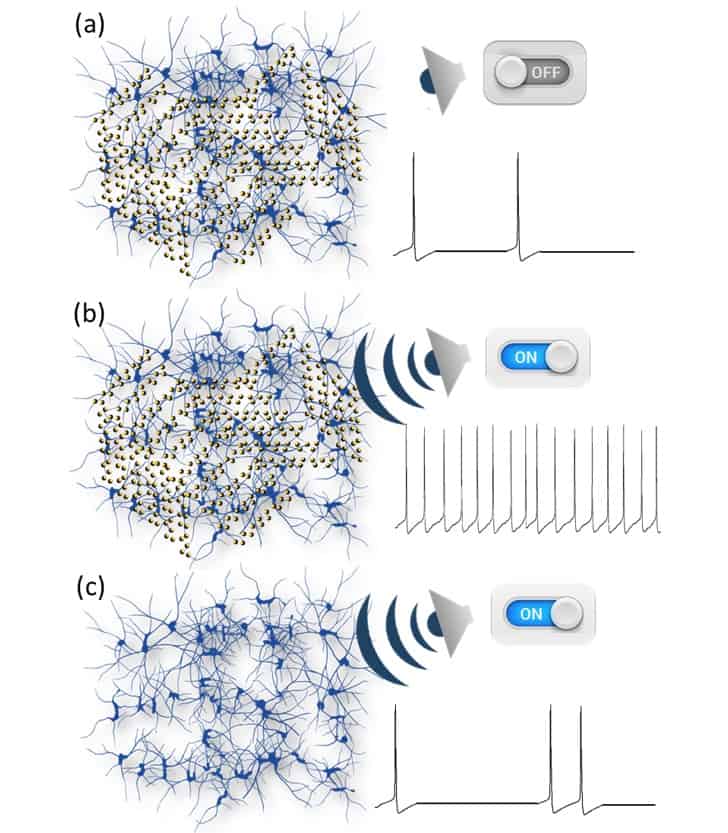
The understanding and treatment of brain function and neurological disorders took a step forward with findings from a study of piezoelectric nanoparticles stimulated by low-intensity pulsed ultrasound. Italian researchers showed that piezoelectric barium titanate nanoparticles (BTNPs) adsorbed on neuronal membranes induced a response to a gentle mechanical stimulation. This offers the potential to use nanoparticles and ultrasound to perform non-invasive and highly selective modulation of the activity of central nervous systems (J. Neural Eng. 15 036016).
The researchers created cultures of hippocampal and cortical neurons taken from the brains of rat embryos and coupled them with micro-electrode arrays (MEAs). BTNPs were prepared, stabilized and incubated within the cell cultures for a few hours.
For the experiments, a planar disc ultrasound transducer was placed on top of the MEA chamber, at 8 mm from the neuronal culture. The stimulation protocol consisted of a series of ultrasound pulses with durations ranging from 0.5 to 1.5 s, delivered at 0.5 Hz. The researchers used each electrode of the MEA to record electrophysiological activity of the neurons. They recorded spontaneous and induced action potentials before, during and after ultrasound stimulation.
The presence and distribution of BTNPs were acquired from fluorescence microscopy images taken on the neuronal cultures upon completion of the experiments. The team evaluated and statistically analysed spike detection, mean firing rate and post-stimulus time histograms.
Lead author Camilo Rojas from the University of Genova and co-authors reported that when neuronal networks incubated with piezoelectric BTNPs were exposed to ultrasound, there was an evident increase in the recorded network activity (spiking and bursting) with respect to spontaneous activity before and after stimulation. This occurred with both cortical and hippocampal cultures.

The authors repeated the stimulation three times on the same network in 5 min intervals. When the ultrasound source was turned off, the neuronal network returned to original baseline levels, demonstrating the reversibility of the induced effects. Experiments repeated using different neuronal preparations from five different animals exhibited reproducible results. The team treated a total of 13 cultures with piezoelectric BTNPs.
The researchers also conducted experiments with a control group of neuronal networks incubated either with non-piezoelectric BTNPs of the same size or without nanoparticles at all. The authors reported that in both cases they never observed a significant response to ultrasound, although the same cultures responded to the electrical stimulation as expected.
Network response
To determine whether the observed firing activity upon ultrasound stimulation was due to the collection of independent single neuron responses or a collective network response, the authors applied a synaptic receptor antagonist “cocktail”. Their objective was to isolate neurons from a network context.
They determined that treatment with blockers of synaptic transmission significantly decreased responses to piezoelectric ultrasound stimulation and that after 10 min, the network did not show any response to electrical stimulation. The authors suggested that this is “an indication that, even if the mechano-electric transduction performed by the piezoelectric BTNPs works at the subcellular level, the measurable effect is at the network level”. Additional experiments aimed at controlling the level of network overall excitability would help better understand the (sub)-cellular mechanisms underlying the obtained network response.
Because the ultrasound-induced responses of the neuronal cultures were reversible, the researchers were able to perform repeated experiments on the same cell culture, such as varying the intensity or pulse duration of ultrasound stimulation. This enabled them to determine the clear dependence and linear relationship between the relative increase in the mean firing rate of the network and the pressure field intensity. “This finding suggests that a possible steering of the network activity can be implemented by fine-tuning the ultrasound amplitude,” they wrote.
The authors suggest that acoustic-electric stimulation enabled by piezo-nanomaterials without genetic intervention is a promising strategy to generate physiologically relevant responses in a minimally invasive way. “We foresee the possibility of highly selective and efficient neural stimulation by providing suitable nanoparticle functionalization to address specific groups of neurons in the central nervous system with virtually single cell resolution, together with the use of focused ultrasound,” they concluded. “This would represent a valuable innovative tool for the generation of new non-invasive neural interfaces.”



